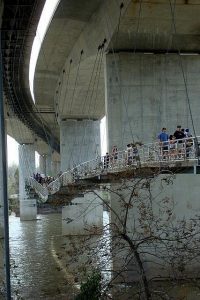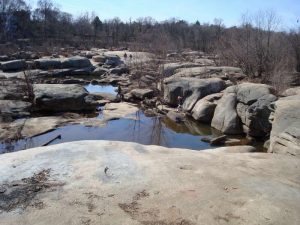After visiting Belle Isle for the first time with the SSIR class, I instantly knew that the place was something special. I returned several weeks later to explore more and be able to really take in my surroundings. The bridge stretching underneath the highway, with its support cables reaching up, reminded me of a sort of web that a spider would make underneath a roof beam. This bridge spanned the distance from civilization in Richmond to a seemingly detached, lost world. There was such an incredible amount of history packed into this tiny, lost world. The Civil War prisoner of war camps were adjacent to the empty shells of iron works buildings, quarries, and hydro-powered machinery. Amongst all of these were traces of our modern era, with there being rock climbing walls and mountain bike courses.
I believe that the popularity of this park in particular, is due to the “wilderness” like nature that it maintains, even with its proximity to the city. At first, the word wilderness does not appear to aptly describe Belle Isle, because the island is littered with roads, trails, and man made structures. However, once you walk onto Belle Isle, you realize that there is an adventurous nature to the island that is not found in most other parks and especially not anywhere near a city. This spirit of adventure feels more similar to the majestic peaks of the Cascades in Oregon, the thrill of flying down backcountry ski slopes in Colorado, or trekking across the slickrock in Utah. People crave these experiences and Belle Isle manages to capture so many of them in such a small space. The way the island is shaped also contributes to a feeling of unknowingness. This is due to the several ridges and dense trees that restrict any large line of sight views.
The simple fact that many of the rusted structures still remain on the island is testament to the adventurous character of the island. Several of these structures on the far side of the island are blocked off with minimal effort, which essentially encourages the climbing and exploration of them. The similarity to the wilderness here has been recreated in a somewhat urban environment that still pays homage to the idea of the romantic sublime. Standing on top of the rocks at the north end of the island that can only be reached by ladder, and being surrounded by trees and many more massive rocks, elicits the same type of response that the classic painting of the romantic sublime era, “Wanderer Above the Sea of Fog” elicits.
While the idea of the sublime and wilderness in general is critiqued in the Cronon article, “The Trouble with Wilderness” Belle Isle demonstrates how an area can combine traditional wilderness with traces of man and be able to stir human emotion in a way that is more profound than just experiencing nature in your backyard and trying to learn to love that, as Cronon suggests. Belle Isle offers the escape that Cronon also critiqued as being for only those who can afford to go on majestic expeditions for entertainment. People in the park seemed truly happy, jumping from rock to rock, kayaking through the rapids adjacent through the park, and flying through the single track trails on mountain bikes. This park caters to people from all walks of life and allows them to remain in touch with the part of their human nature that desires adventure and natural beauty.
In order to maintain and preserve this park, there must be active, ongoing efforts to build community around it. I do not believe that Belle Isle faces very much danger from Forsyth’s theory of “place blindness” because of how it is separated from the city, and the gates to the bridge lock at night. This separation is part of what makes Belle Isle unique, because it functions as an escape from city life. In this sense, development and urban sprawl aren’t as much of issues as tax dollar funding and basic clean-up efforts are. In addition, because Belle Isle is relatively large for the river, it can function as a sort of riparian zone. The separation from the city allows for more protection against various forms of environmental degradation, such as hydrologic drought from paving surfaces and large scale deforestation. The environment in Belle Isle can be left to undergo natural erosion as the river rushes across its banks. This bank erosion could be seen by the very small square of pavement by the water’s edge that we saw during the class trip and that was slowly crumbling away.
Henry David Thoreau’s declaration that, “In Wildness is the preservation of the world” exemplifies the idea behind the “personality” of Belle Isle as a park, the need for environmental protection, and why humans are drawn to areas such as Belle Isle. I attribute the massive popularity of Belle Isle as a park, which can be seen in the constantly packed parking lot, to the wilderness-like aspect of it that also contains man made historical elements. The natural geography contributes to its draw, because of its isolation from the city. While Central Park, in New York City, is also a large park in an urbanized area, it does not retain the “sublime” appeal that Belle Isle does because it does not feel separated from the city as much. The suspension bridge to Belle Isle functions as a bridge to another world, one where people can experience adventure and remain in touch with nature.


